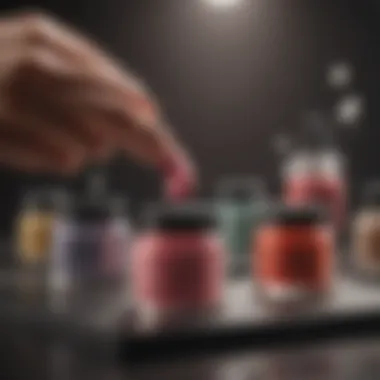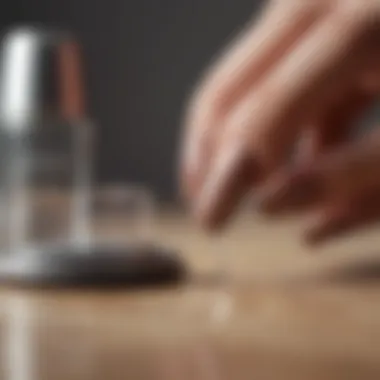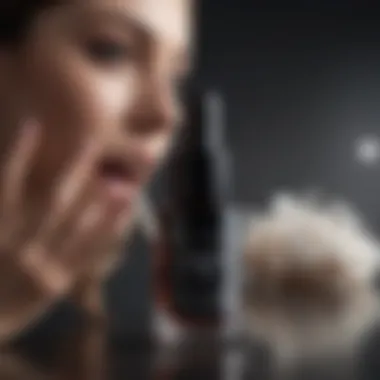Expert Guide to Safely Remove Dip Powder Nails


Intro
Removing dip powder from nails is an essential skill for those who regularly use this increasingly popular nail enhancement method. Dip powder manicures are known for their long-lasting finish, vibrant colors, and durability. However, when it's time to remove the dip powder, doing it correctly is crucial to maintaining nail health. This article provides a thorough guide to effectively and safely remove dip powder while also addressing common concerns and offering post-removal care tips. Whether you are seeking a DIY method or professional insights, this guide is tailored for women of all ages who wish to enhance their beauty routine.
The Importance of Proper Removal
Dip powder, while aesthetically pleasing, can damage nails if not removed properly. The acrylic components in dip powder can weaken natural nails if subjected to harsh removal techniques. Therefore, understanding the right tools and methods is vital. When performed incorrectly, the removal process can lead to peeling, splitting, or other forms of damage. This guide presents the best practices to mitigate those risks and ensure your nails remain strong and beautiful.
"Proper nail care is not merely about aesthetic; it is about maintaining the health of your nails and, ultimately, your hands."
Recommended Tools for Removal
For successful dip powder removal, having the right tools on hand makes a significant difference. Here is a list of essential items:
- Acetone: The most effective solvent for dissolving dip powder.
- Nail File: A coarse file to gently buff the surface of the nail.
- Cotton Balls or Pads: For applying acetone.
- Aluminum Foil: Useful to wrap around the nails with acetone-soaked cotton.
- Cuticle Pusher: To gently scrape away the residual powder after soaking.
- Nourishing Oil or Cream: To moisturize the nails post-removal.
These tools facilitate a smoother, more efficient removal process while maintaining nail health.
Methods of Removal
There are primarily two methods for removing dip powder: the soaking method and the filing method. Each has its advantages and offers a different experience based on personal preference.
Soaking Method
This method is the most commonly recommended for a gentle approach:
- Begin by buffing the top layer of the dip powder using the nail file. This helps the acetone penetrate the coating more effectively.
- Soak cotton balls or pads in acetone and place them on each nail.
- Wrap each nail with aluminum foil to keep the acetone in contact with the dip powder.
- Wait for about 10-15 minutes, allowing the acetone to dissolve the powder.
- Carefully remove the foil and cotton, then gently push off the dip powder with a cuticle pusher. Repeat as necessary until all powder is removed.
Filing Method
Some individuals prefer filing, particularly if they need a faster solution:
- Use a coarse nail file to carefully file away the dip powder from the surface.
- Be cautious not to file too aggressively, as it can damage the natural nail underneath.
- If necessary, finish with the soaking method for any remaining product.
Both methods aim to prioritize nail health, so choose one based on comfort and convenience.
Post-Removal Care
After successfully removing dip powder, addressing potential nail damage is vital for recovery. Here are a few tips:
- Hydrate: Apply nourishing oil or hand cream to restore moisture.
- Avoid Further Treatments: Give your nails a break from all enhancements for at least a week.
- Diet Considerations: Include vitamins necessary for nail health, such as biotin.
- Gentle Filing and Buffing: Once nails have recovered, maintain their shape and smoothness without aggressive filing.
In summary, understanding the correct methods and tools for removing dip powder is crucial for preserving nail integrity. Regular maintenance and accountability in one’s beauty routine contribute to overall nail health, ensuring that hands remain an elegant focal point.
Understanding Dip Powder Nails
Dip powder nails have gained immense popularity in the beauty community. Understanding their structure, benefits, and common concerns is the first step towards effective removal. This section aims to clarify what dip powder nails are, the advantages they provide, and potential issues that may arise, which are critical factors in maintaining nail health.
Definition and Composition
Dip powder nails consist of a base coat, color powder, and a top coat. The process involves applying a bonding agent to the natural nail, followed by dipping it into colored powder. A sealant is then applied to lock in the color. The composition of dip powder generally includes acrylic polymers and pigments that create a durable finish. This method differs significantly from traditional nail polish, offering a longer-lasting solution with a glossy appearance. Understanding these components helps in grasping why proper removal is essential to protect the nail bed.
Benefits of Dip Powder Nails
The popularity of dip powder nails can be attributed to several benefits:
- Longevity: They can last up to three weeks without chipping, outpacing conventional nail polish.
- Variety: A wide range of colors and finishes allows for personal expression.
- Durability: Dip powder nails tend to be less prone to breaking compared to acrylics or gels.
- Quick Application: The process can be faster than traditional applications, appealing to busy individuals.
These advantages position dip powder nails as an attractive option for women looking for durability and beauty in their manicures.
Common Concerns with Dip Powder


While dip powder nails have notable benefits, they come with some common concerns.
- Nail Damage: If not removed properly, they can lead to thinning of the natural nail.
- Allergic Reactions: Some individuals may experience skin irritation or allergic responses to chemicals used in the process.
- Maintenance: Regular fills are required, which can lead to an accumulation of product on the nails over time.
Awareness of these concerns is crucial. It enables users to take necessary precautions and ensure their nail health is not compromised. By understanding dip powder nails in-depth, you can move forward with confidence in the removal process, which will be outlined in the following sections.
Preparing for Removal
Before delving into the specific methods of removing dip powder from nails, it is crucial to understand the preparations necessary for an effective and safe removal process. Proper preparation not only facilitates a smoother experience but also minimizes the risk of damaging your natural nails and surrounding skin. Thus, taking the time to gather the essential tools and create a conducive environment can greatly enhance the efficiency of the removal process.
Essential Tools Needed
Using the right tools is important for a successful dip powder removal. Each tool plays a significant role in ensuring that the process is not only effective but also gentle on your nails.
Acetone or Non-Acetone Removers
Acetone is a strong solvent widely used for nail polish removal. Its effectiveness in breaking down dip powder is well-documented. However, it can lead to dryness of both the nails and the skin surrounding them. Non-acetone removers, on the other hand, are less harsh and can be preferable for individuals with sensitive skin or nails. While they may require more time to work, they are often considered a gentler alternative.
Being aware of the concentration of acetone in your chosen remover is also helpful. A higher concentration typically means faster results, but that comes with the cost of increased dryness. Thus, it is vital to weigh the benefits and drawbacks when selecting your remover, taking into account your particular needs and tolerance.
Nail File
A nail file is an essential tool for gently reducing the thickness of the dip powder before soaking. This initial step helps the remover penetrate more effectively. One of the key characteristics of a nail file is its grit level; a finer grit is less abrasive and can be less damaging to the natural nail.
When using a nail file, it’s important to avoid aggressive filing, as this can lead to thinning of the natural nail. Instead, a gentle back-and-forth motion should be employed. The unique feature of a nail file lies in its ability to prepare the nail surface for the soaking phase, ultimately improving the efficiency of the removal process.
Cotton Balls or Pads
Cotton balls or pads are practical and effective for applying the acetone or remover to the nails. Their absorbent nature ensures that the product is adequately distributed over the surface of the nail. The primary characteristic of cotton in this regard is its softness, which prevents irritation when applied to sensitive skin.
One advantage of using cotton balls or pads is their ease of use; simply soak them in the remover and place them on the nails without mess. However, it is crucial to ensure that they are adequately saturated, as dry cotton will not effectively remove the dip powder. They are an indispensable part of the removal toolkit.
Aluminum Foil
Aluminum foil serves an essential role in the dip powder removal process. It is utilized to wrap the soaked cotton around each nail, creating a barrier that helps retain heat and moisture. This enhances the effectiveness of the acetone or remover by allowing it to work more efficiently.
A key characteristic of aluminum foil is its flexibility and adaptability, making it easy to shape around the fingers. Yet, it is important to ensure that it wraps tightly enough to avoid slipping off during the soaking period. The use of aluminum foil thus contributes significantly to a more effective and quicker removal procedure.
Wooden Cuticle Stick
After the soaking period, a wooden cuticle stick becomes a helpful tool for gently pushing off any remaining dip powder. Its pointed end can assist in picking up stubborn residues. A notable advantage of a wooden cuticle stick is that it is generally safer for the nail bed compared to metal alternatives, reducing risks of damaging the natural nail.
Its unique feature is the natural wood material, which is less likely to irritate the skin. Care must be taken, though, to avoid applying excessive pressure when using it, as this can lead to discomfort or damage.
Creating a Conducive Environment
Setting up a proper workspace can greatly influence the ease and effectiveness of the dip powder removal process. Find a space where you can work comfortably without distractions. Additionally, ensuring good lighting can help you see the progress of the removal better.
Utilizing a protective covering on your work surface, like a towel, can help catch any drips from the acetone or remover. This precaution facilitates easy clean-up afterward. Finally, having a timer nearby can assist in monitoring soaking durations for each nail, ensuring that the process is efficiently managed.
Taking these steps will create a suitable environment for the removal process, making it more effective and pleasant.
Methods of Dip Powder Removal
Removing dip powder from nails requires careful consideration, as improper techniques can lead to damage. This section emphasizes various methods that can be employed for effective dip powder removal. Understanding these methods is crucial for maintaining nail health and achieving a clean finish. Each method brings its own set of benefits and risks, allowing individuals to choose what best fits their needs.
Soaking Method
The soaking method is a widely recognized technique for removing dip powder. This method relies on a liquid solution to gently dissolve the powder, offering a less abrasive approach compared to filing. It is a popular choice as it minimizes the risk of damage to the natural nail, making it a preferred option for many.
Step-by-Step Guide
The step-by-step guide for the soaking method involves several straightforward steps:


- Start by buffing the top layer of dip powder gently.
- Soak cotton balls in acetone.
- Place the soaked cotton on each nail.
- Wrap the cotton and nail with aluminum foil to hold it in place.
- Wait for about 10-15 minutes.
- After soaking, gently push off the dip powder with a wooden cuticle stick.
This guide simplifies the process, emphasizing its practicality and efficiency. The main characteristic of this guide is the ease with which it can be followed at home. This method is especially beneficial for individuals who want to avoid the harshness of filing, thus preserving the integrity of their nails.
Duration for Soaking
The duration for soaking is a key aspect one must pay attention to. Generally, soaking should last between 10 to 15 minutes. This timing is critical because too short a soak may leave residue, while too long can lead to nail dehydration. The unique feature of this duration is the balance it achieves between effectiveness and safety.
- Advantage: Effectiveness in dissolving dip powder.
- Disadvantage: Over-soaking can weaken nails.
Tips for Effective Soaking
For those choosing to use the soaking method, applying some tips for effective soaking can enhance the removal experience. Here are a few tips:
- Use pure acetone for a faster process.
- Ensure the cotton is adequately saturated for best results.
- Avoid touching the nail bed with the wooden stick during removal to prevent damage.
These tips are beneficial because they refine the soaking process, ensuring success. Their main characteristic is their practical nature, making them simple yet effective.
Filing Technique
The filing technique offers an alternative for those who prefer a more direct approach to remove dip powder. This method requires more caution but can be efficient when done correctly.
Step-by-Step Guide
The step-by-step guide for the filing technique includes:
- Use a coarse nail file to gently file the surface of the dip powder.
- Gradually reduce pressure to avoid damaging the natural nail.
- Continue filing until the powder is almost completely gone.
- Finish with a smoother nail file for a clean surface.
This guide provides a clear pathway for users to follow. It is notable for its effectiveness, especially for individuals who are familiar with nail care. However, it requires care and patience to avoid over-filing, which can harm the natural nail.
Considerations to Keep in Mind
When opting for the filing technique, it is important to consider the following:
- Pressure Control: Use light pressure to avoid injury.
- File Quality: Invest in good quality files to minimize trauma to nails.
- Technique: Work slowly and methodically to ensure thorough removal.
These considerations enhance overall safety during the process. They are essential, especially for individuals who may rush through the steps. The unique feature of this technique is the personal touch involved, allowing users to control the process.
Combination Method
For those who desire a blend of both methods, the combination technique can be advantageous. This method utilizes soaking followed by filing, thus maximizing efficiency.
Using Both Soaking and Filing
Using both soaking and filing creates a balanced approach where the soaking softens the dip powder, allowing for easier filing. This method is effective in ensuring thorough removal without excessive pressure applied to the natural nail.
- Advantage: Reduces filing time and nail damage.
- Disadvantage: Requires more time than a standalone method.
Best Practices for Combination
To maximize the effectiveness of the combination method, consider the following best practices:
- Start the process with soaking to loosen the dip powder.
- Use a gentle filing technique after soaking to remove any remaining bits.
- Monitor your nails throughout the process to prevent excessive trauma.
These practices improve the effectiveness of the method while safeguarding your nails against damage. They highlight the importance of a thoughtful approach in achieving optimal results.
Potential Risks and Precautions
Removing dip powder nails requires care and awareness to avoid potential hazards. Understanding the risks associated with this process is crucial for maintaining nail health and avoiding complications. This section outlines the most important considerations when it comes to dip powder removal, ensuring you take the necessary precautions for a safe experience.
Damage to Natural Nails
One of the primary concerns during dip powder removal is the risk of damage to natural nails. The application of dip powder involves multiple layers, which can lead to weakened nail beds after removal. When using acetone, excessive soaking or improper techniques can exacerbate this issue. It is vital to monitor the state of your nails regularly.


Here are a few tips to help mitigate damage:
- Limit Soaking Time: Avoid prolonged exposure to acetone. Prolonged soaking can make nails brittle.
- File Gently: When filing to remove powder, use a gentle touch. Strong pressure can thin the natural nail layer.
- Nail Conditioners: Consider using a nourishing nail conditioner post-removal to aid recovery.
Skin Irritation and Allergic Reactions
Some individuals may experience skin irritation or allergic reactions during the dip powder removal process. Acetone and other chemical removers can be harsh on sensitive skin, leading to dryness or inflammation. It is prudent to test for sensitivities, especially if you have a history of skin issues.
To avoid skin irritation:
- Use Gloves: Wearing disposable gloves can protect your hands from direct contact with chemicals.
- Patch Test: Conduct a patch test on a small area of skin before using a new remover.
- Choose Non-Acetone Options: If you notice irritation with acetone, consider using a non-acetone remover that tends to be less harsh.
Avoiding Common Mistakes
While removing dip powder nails, it is essential to avoid common mistakes that can lead to undesirable outcomes. Many individuals may rush through the process or skip crucial steps, which can result in significant damage.
Consider these tips to avoid pitfalls:
- Rushing the Process: Take your time with each step to ensure a thorough removal of dip powder.
- Neglecting Aftercare: Ignoring post-removal conditioning can exacerbate damage. Always follow up with nail nourishment.
- Using Improper Tools: Ensure you have the right tools for the job. Improvising tools can lead to injury or ineffective removal.
"Proper removal is just as important as application. Your nails deserve careful handling."
By understanding these risks and implementing appropriate precautions, you can facilitate a smoother and safer dip powder removal process. Taking these recommendations to heart ensures that your natural nails remain healthy and vibrant.
Post-Removal Care
Taking care of your nails after removing dip powder is crucial to maintaining their health and strength. The removal process can leave nails vulnerable and weak. Engaging in effective post-removal care can replenish moisture and reinforce the structure of your nails. By ensuring optimal nail health, you can prevent future damage and prepare for new nail applications.
Nourishing Your Nails
Using Oils and Treatments
Using oils and treatments for your nails is one of the best ways to promote recovery. Oils, such as jojoba or almond oil, are absorbed easily and can provide deep hydration. The main characteristic of these oils is their ability to penetrate the nail bed. Their use is a popular choice for nourishing compromised nails because they help restore necessary moisture.
These oils contain essential fatty acids that can support nail growth. Additionally, they may prevent brittleness following the removal of dip powder. The main advantage of using oils is their natural composition, meaning they are less likely to cause irritation compared to chemical treatments. However, it’s vital to ensure that your nails are clean and free from residue before applying any oils for maximum absorption.
Hydration Tips
Hydration is another vital aspect of post-removal care. Keeping your nails hydrated can significantly impact their overall health. This characteristic makes hydration an essential practice in nail care routines. Increasing your water intake is one easy and effective way to ensure your nails remain well-hydrated from the inside out.
Moreover, using a hydrating hand cream can aid this process. Many creams contain ingredients like shea butter and vitamin E, which provide additional nourishment to your nails and cuticles. These ingredients can help restore elasticity and prevent cracks. However, while both drinking water and using hydrating creams are generally beneficial, remember to balance them to avoid an overload of moisture, which can lead to weakened nails.
Monitoring for Damage
After removing dip powder, it is essential to monitor your nails for any signs of damage. Regular checks can help catch issues early, such as peeling or discoloration. If you notice your nails are not recovering well, modifying your nail care routine might be necessary. Keeping a close eye on any changes allows for prompt action to mitigate further damage.
Reapplying Nail Products Safely
Once your nails have sufficiently recovered, reapplying nail products can be tempting. However, it’s vital to do this safely. Choose high-quality products that promote nail health rather than compromise it. Look for products that are labeled as "3-free" or "5-free" which indicates the absence of harmful chemicals. This is a major consideration, as harsh chemicals can further weaken nails after significant removal processes. Gradually reintegrating these products, rather than applying them all at once, can also help in assessing their effects on your nails.
When to Seek Professional Help
In the context of removing dip powder from nails, there comes a time when seeking professional assistance is not just a choice but a necessity. The process is generally safe for at-home execution, but there are scenarios where the risk of damage escalates, requiring expert intervention. Recognizing these moments can preserve the integrity of your nails and overall nail health. Before attempting removal, it is essential to understand signs of severe problems and the right approach to finally visit a salon.
Signs of Severe Damage
There are several indicators that may point to significant nail damage after dip powder application. These signs warrant immediate professional care:
- Visible Cracking or Splitting: If your natural nails show signs of cracking, this could mean they are compromised. To avoid further injury, a professional can assess the situation adequately.
- Persistent Pain or Discomfort: If you experience ongoing discomfort in your nails or cuticles, it might be a signal that the removal process has exacerbated underlying issues. A professional will have the skills to diagnose and treat whatever underlying problems exist.
- Severe Nail Lifting: When a dip powder coating lifts significantly from the nail bed, this could allow moisture to enter and increase the risk for fungus. You should consult a professional who can provide safe solutions to avoid infection.
A nail expert can guide you through the recovery and care of your nails, ensuring the safe removal of any residual product while addressing damage properly.
Choosing the Right Salon
Finding the right salon for your nail needs can prove crucial, especially when dealing with significant damage that arises from the removal of dip powder. Here are some factors to consider:
- Research and Reviews: Look at customer reviews online. Websites like reddit.com can offer insights into local salons. Positive feedback from other clients can serve as a good starting point.
- Qualifications and Experience: Confirm that the nail technicians are trained in dip powder removal methods. Their experience can directly impact the quality of service and care you receive.
- Sanitary Practices: Pay attention to the hygiene of the salon. Clean tools and a tidy environment are essential for preventing infections.
Selecting the right salon can greatly enhance your experience and ensure that you receive the best possible care for your nails. Always prioritize safety and health over aesthetics.



